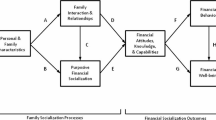Abstract
The revised Treasury Regulations interpreting Internal Revenue Code Section 482 allow the use of profit-based transfer pricing methods, as well as the older methods based on prices from comparable transactions between independent parties. This paper compares the effects of price-based and profit-based transfer pricing methods on the allocation of taxable income in a model in which organization structure affects the level of relationship-specific investments made by vertically integrated groups and comparable independent firms. Analysis of the model shows that the price-based methods systematically allocates more taxable income to foreign subsidiaries and less to domestic parents than does the profit-based method.
Similar content being viewed by others
References
Alchian, A., and H. Demsetz. (1972). “Production, Information Costs, and Economic Organization.” American Economic Review 62, 777–795.
Antle, R., and G. Eppen. (1985). “Capital Rationing and Organizational Slack in Capital Budgeting.” Management Science 31, 163–174.
Chipty, T., and A. Witte. (1990). “Some Thoughts on Transfer Pricing.” Tax Notes 49, 1009–1024.
Coase, R. (1937). “The Nature of the Firm.” Economica 4, 386–405.
Copithorne, L. (1971). “International Corporate Transfer Prices and Government Policy.” Canadian Journal of Economics 4, 324–341.
Diewert, W. (1985). “Transfer Pricing and Economic Efficiency.” In A. Rugman, and L. Eden (eds.), Multinationals and Transfer Pricing. New York: St. Martin's Press.
Eden, L. (1985). “The Microeconomics of Transfer Pricing.” In A. Rugman, and L. Eden (eds.), Multinationals and Transfer Pricing. New York: St. Martin's Press.
Goldberg, F. (1990). “Testimony of Fred T. Goldberg, Jr., Commissioner of Internal Revenue, before the Subcommittee on Oversight, House Ways and Means Committee on July 10, 1990.
Grossman, S., and O. Hart. (1986). “The Costs and Benefits of Ownership: A Theory of Vertical and Lateral Integration.” Journal of Political Economy 94, 691–719.
Halperin, R., and B. Srinidhi. (1987). “The Effects of the U.S. Income Tax Regulations' Transfer Pricing Rules on Allocative Efficiency.” The Accounting Review 62, 686–706.
Halperin, R., and B. Srinidhi. (1996). “U.S. Income Tax Transfer Pricing Rules for Intangibles as Approximations of Arm's Length Pricing.” The Accounting Review 71, 61–80.
Harris, D., and R. Sansing. (1998). “Distortions Caused by the Use of Arm's Length Transfer Prices.” Journal of the American Taxation Association 20 (Supplement), 40–50.
Higinbotham, H., D. Asper, P. Stoffregen, and R. Wexler. (1987). “Effective Application of the Section 482 Transfer Pricing Regulations.” Tax Law Review 42, 295–380.
Holmstrom, B., and J. Tirole. (1989). “The Theory of the Firm.” In R. Schmalensee and R.Willig (eds), Handbook of Industrial Organization, Volume 1. New York: North-Holland.
Horst, T. (1971). “Theory of the Multinational Firm: Optimal Behaviour Under Differing Tariff and Tax Rates.” Journal of Political Economy 79, 1059–1972.
Hufbauer, G. (1992). U.S.Taxation of International Income: Blueprint for Reform. Washington, D.C.: Institute for International Economics.
Joskow, P. (1985). “Vertical Integration and Long-term Contracts: The Case of Coal-burning Electric Generating Plants.” Journal of Law, Economics, and Organization 2, 33–80.
Langbein, S. (1989). “Transaction Cost, Production Cost, and Tax Transfer Pricing.” Tax Notes 45, 1391–1413.
Masten, S. (1984). “The Organization of Production: Evidence from the Aerospace Industry.” Journal of Law and Economics 1, 403–418.
Monteverde, K., and D. Teece. (1982). “Supplier Switching Costs and Vertical Integration in the Automobile Industry.” Bell Journal of Economics 13, 206–213.
Nash, J. (1950). “The Bargaining Problem.” Econometrica 18, 155–162.
Sansing, R. (1996). “Transfer Pricing and the Taxation of Natural Resource Extraction.” Journal of Energy Finance & Development 1, 71–81.
Shelanski, H., and P. Klein. (1995). “Empirical Research in Transaction Cost Economics: A Review and Assessment.” Journal of Law, Economics, and Organization 11, 335–361.
Stuckey, J. (1983). Vertical Integration and Joint Ventures in the Aluminum Industry. Cambridge, Harvard University Press.
Taly, M. (1996). “Comparison of CPM and TNMM Transfer Pricing Methods: A Point of View.” Tax Notes International 12, 351–354.
Turner, R. (1997). “International Transfer Pricing Rules from a Canadian Perspective.” Tax Notes International 15, 297–310.
Turro, J. (1994). “Transfer Pricing: U.S. Releases Final Transfer Pricing Regulations Under Section 482.” Tax Notes International 9, 79.
Williamson, O. (1985). The Economic Institutions of Capitalism. Glencoe, IL: Free Press.
Wilson, P. (1993). “The Role of Taxes in Location and Sourcing Decisions.” In Studies in International Taxation. Aberto Giovannini, R. Glenn Hubbard, and Joel Slemrod (eds.), Chicago: University of Chicago Press.
Author information
Authors and Affiliations
Rights and permissions
About this article
Cite this article
Sansing, R. Relationship-Specific Investments and the Transfer Pricing Paradox. Review of Accounting Studies 4, 119–134 (1999). https://doi.org/10.1023/A:1009601102396
Issue Date:
DOI: https://doi.org/10.1023/A:1009601102396




